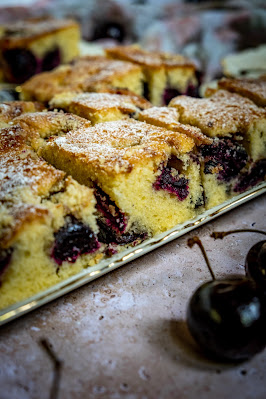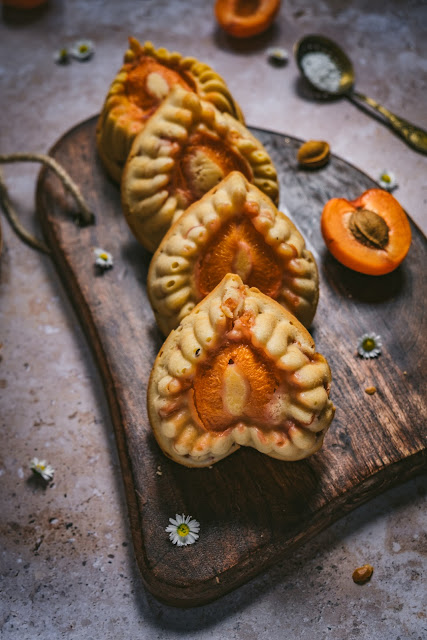Cauliflower steak
Lemon-cardamom oil cake (baked in air fryer)
The best oil to use for this cake is by far olive oil. However, the cake can be made with any vegetable oil. I had in my pantry an open bottle of peanut oil and I wanted to use it, so this is the oil I used for this cake.
When I bought my air fryer I had no clue how versatile such a mini oven could be for baking cakes. Actually, they turn out even better than in my good old kitchen oven. There is however a limitation to baking in the air fryer and that is the size. My air fryer drawer is 24 cm wide, so only pans under this dimension can fit inside.
As for the pan, some time ago this silicone daisy mould caught my eye and I fell for it. However, I had plenty of cake pans and moulds and I was hesitant to extend my collection because of the limited space to store them. With the air fryer, I had to evaluate all the pans I owned and select the ones fitting the drawer. I did not count many for this purpose. That was the moment when I recalled this small daisy silicone mould left waiting on my wish list. The next step was obvious, this beautifully shaped mould joined my collection.
The recipe is an adapted one. The original one is with orange, not lemon-based. As it is more often to have lemon in the house rather than oranges I changed to lemon. I also had to adapt other quantities like (you guessed what if you know me...) sugar and improve the structure in the absence of sugar by adding more flour.
I am very happy with the result. It is a super moist cake, not very sweet and with a distinct aroma due to the cardamom.
Soured Cream Chocolate Cake (baked in the air fryer)
This year I started a new adventure in cooking dishes into the air fryer. Cakes, of course, were on the list to test and I was surprised to see that they actually turned out very well. There are some parameters to tinkle but I was really surprised with the results.
This cake recipe is adapted from a new recipe book I bought. I was disappointed that the book had photos for only 1/4 of the recipes. In the era where videos of recipes rule the internet, a cake book without pictures to inspire and motivate you to bake for me is essential. I was at the point of returning the book but decided to test some recipes first. The resulting cakes, even adapted by myself (you know me, I cut the sugar from everywhere) were surprisingly nice. So, I decided finally to keep the book. I still feel like in the times of my mother where you could have just imagined how a cake could turn while reading a recipe because there was no image to show. I give you then my touch and present the final image of the cake here.
The cake is very moist, not very sweet and not bitter either. I would try even one more change next time, by replacing 20g of cocoa powder with all-purpose flour.
Enjoy!
Nezuko Cake
This weekend we celebrated the 11th anniversary of my daughter. At this age, doll cakes are not in fashion anymore, so I followed her taste. Nezuko is her favourite character, so you can imagine that the cake should have been related.
Luckily, her mother bought a plotter recently, so making stencils was a piece of cake (or should have been...). Her mother also added to her tools collection a cake airbrush for this occasion. I can only conclude that, me, as her mother, sometimes I challenge myself maybe too far. But in the end, for my first stencilled cake, it doesn't look that bad. The most important thing was achieved, my daughter was very proud of her anniversary cake and me, in this way I achieved my goal, to make a cake to be remembered.
40% Kamut Sourdough Bread
Today, I made a 40% kamut sourdough bread.
But what is kamut?
Kamut is an ancient grain thought to be a cousin of durum, with a grain that is at least twice the size of modern wheat. This grain comes with nice stories behind it and has many given names. In 1949, a US airman purchased 36 kernels from a vendor in Cairo who claimed to have taken them from a tomb of an ancient Egyptian king. He brought this grain to his father who had a farm and planted them. They called it King's Tut wheat but they had only small local success with it. It was just later in the 1990 that kamut became a commercial success after being trademarked to protect and guarantee that it would be grown organically and unmodified. Demand started to grow when people found kamut to be more easily digested and more flavoured compared to modern wheat varieties.
Although the last part of the story is certain, the origin of this grain is debatable as it is highly unlikely that wheat grains could sprout after 2000 years as the seeds' ability to germinate is almost lost during this time.
Another legend says that Noah brought this khorasan wheat with him on the ark, from where, another name for kamut is the “Prophet’s Wheat".
Also, the farmers in Turkey call the grain “Camel’s Tooth” because of its specific shape.
Kamut flour has a yellowish colour and tends to have higher water absorption. A dough made with it, forms good elasticity but is less well performing in extensibility, resulting in dough with less volume and denser texture.
Chicken Soup in Instant Pot
I make this soup at least 2 times a month for years. It became my classic recipe for soup.
The initial recipe I posted here: Traditional chicken soup. I made this soup in all sorts of ways: in a traditional pressure cooker, in a regular big pot but since I've got my Instant Pot, it is the only way I do it.
The soup is so versatile, it can accept all types of vegetables that are left over in the fridge like an eggplant, a zucchini or more tomatoes/bell peppers.
The advantage of the Instant Pot is that I can cook the chicken straight from the freezer, skipping the time to defrost them. I do not even need to cut them because, in the end, the meat simply falls out of the bones and you can break them with just a simple spatula.
There is a secret ingredient that for me is a must: the lovage. You might not be familiar with this herb but its flavour fits amazingly with the soup. During the summer I enjoy the fresh lovage leaves but during the winter I use the dried version of it. In case you do not have it available, use parsley.
I am not sure if I can "advertise" more this soup.
Below is the adapted recipe for the Instant Pot.
Cherry pound cake
A pound cake usually is a simple recipe with 1:1:1:1 ratio of ingredients. This means that you put inside the same quantity of butter, sugar, flour and eggs. Well, that's the theory. Practically, adding that much sugar for me is a bit too much considering that these black fresh cherries are also super sweet. I then cut the sugar in 2. Sweetness turned out just perfect for me.
Even if I love this recipe, I am tempted to play with some of the quantities to adjust to the height of the glass pan that I have.
I made many cherry cakes over the years, and most of the time I used another method, first foaming the egg whites, then the yolks and gently mixing in the flour. That recipe has no added fats and tastes drier even the cherries add moisture inside. This recipe starts by beating the butter with sugar that will create bubbles and just then, adding the eggs. The taste and texture are on the other side of the scale: creamy, soft, wetter.





















